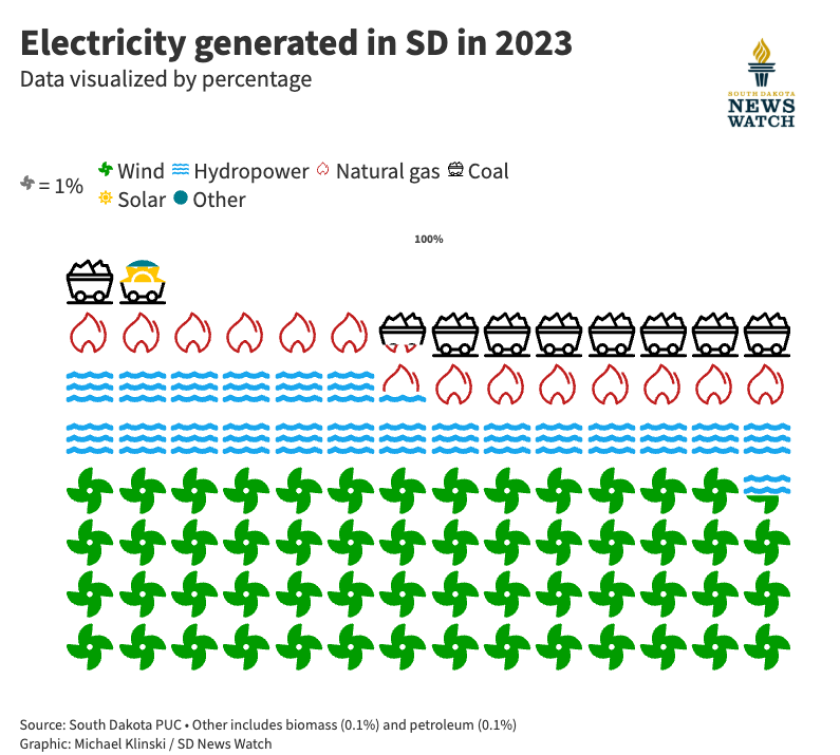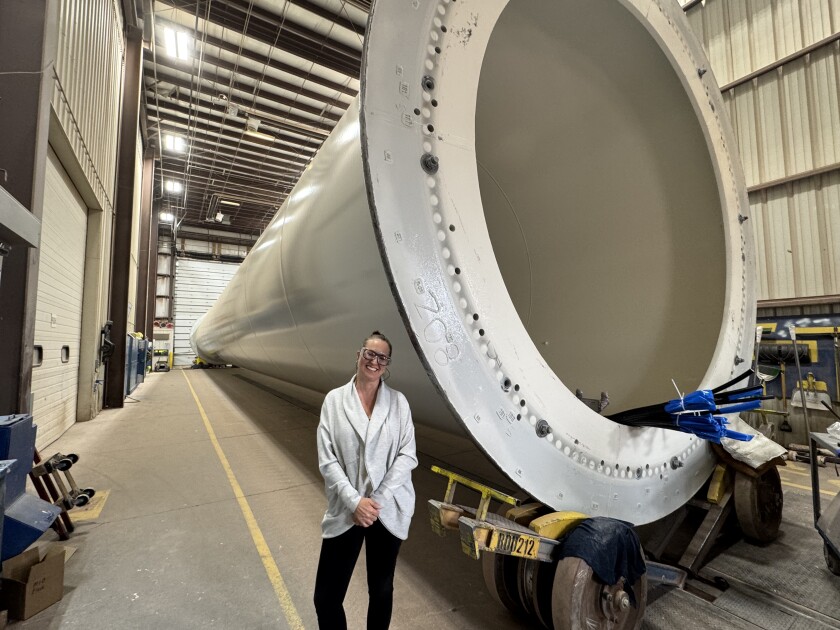MITCHELL, S.D. — Matthew Pearson found a successful career in the wind energy industry purely by chance.
After graduating from high school in Vermillion, Pearson knew he didn’t want to pursue a four-year degree and instead scrolled through the list of majors offered at Mitchell Tech, one of the state’s four technical colleges.
“When I came to the wind energy program, I thought, ‘Well, that sounds kind of cool,” Pearson, 28, recalled during a recent interview at Mitchell Tech, the only South Dakota college with a designated wind energy major.
He didn’t know it at the time, but Pearson had stumbled into one of the fastest-growing, highest-paying trade fields in the state and nation.
While workforce shortages plague many industries and employers in the Rushmore State, great opportunities abound for skilled workers to build, operate and maintain renewable energy facilities, including at wind farms. Meanwhile, strong partnerships between technical colleges, employers and the Build Dakota Scholarship program have forged a ready pathway to quickly and effectively fill the need for energy workers.

Bart Pfankuch / South Dakota News Watch
Pearson obtained a Build Dakota Scholarship that paid all tuition for a two-year wind technology degree, then spent about $15,000 to complete another two-year major in electrical construction.
After graduation, he quickly landed a job wiring wind towers at locations around the country. He was initially paid about $80,000 a year, and after six years was making $127,000 plus a daily living fee of $140.
But now, with a fiancee and two children, Pearson is completing a circle by leaving field work and returning to Mitchell Tech to become its only wind energy program instructor.
“There’s been a steady uptick in the need for workforce,” he said. “When I would get to a jobsite, there would be three or four companies there, and they’d always come over and ask, ‘Hey, you want to come work for us instead?’”
About 77% of the power used in the state comes from non-fossil fuel sources, largely from water and wind, according to the U.S. Energy Information Administration. The state has three solar farms but no plans filed for more.
Over roughly the past 15 years, the state has seen a tenfold increase in wind energy production, according to the state Public Utilities Commission.

In 2009, the state had 190 turbines capable of producing about 350 megawatts (MW) of electricity. At the end of 2024, South Dakota was home to 1,417 turbines able to generate about 3,600 MW of energy. The PUC also approved a 68-turbine project with a capacity of 260 MW and a $621 million price tag near Clear Lake in March.
“We’ve had just a tremendous expansion of wind energy in South Dakota,” said Chris Nelson, a PUC commissioner. “Today, though, we’re in a little bit of a lull.”
The expected slowdown is due to a lack of transmission lines capable of carrying more power, most of which heads east out of the state, Nelson said.
Two nonprofit energy consortiums that manage the power grid in the upper Midwest plan to spend a combined $37 billion to expand transmission capacity, including in South Dakota, over roughly the next decade.
At Lake Area Technical College in Watertown, students are offered two energy-related degree tracks, said president Tiffany Sanderson.
The energy technology major provides training in development and maintenance of energy systems, and the energy operations degree is aimed at managing an energy facility.
The two programs have about two dozen students combined, Sanderson said. In the 2023 graduating class, 100% of all graduates were employed within six months, with average salaries of $65,000 a year in the technology major and $69,000 a year in operations.
“That is for their first jobs in the industry, so those are tremendous opportunities for a brand new graduate with two years of college education,” she said.
In May, Nathaniel Bekaert will become one of those new graduates from Lake Area tech.
Bekaert, 28, grew up on a farm and came to the college after six years in the U.S. Army, which paid for almost all of his tuition, fees and equipment costs.
“The more you learn, the more you want to dive into it,” he said.

Bart Pfankuch / South Dakota News Watch
With his anticipated degree and work experience, Bekaert said he was recruited extensively by energy companies.
“The amount of energy companies coming in looking for workers is crazy, and you can’t really grasp how many companies are looking for energy students,” he said.
As a native of the Watertown area, Bekaert has accepted a job close to home as a wind technician at the Crowned Ridge wind farm northeast of the city, where he will make $29 an hour plus a $5,000 signing bonus and a $200 annual stipend for work boots.
The South Dakota technical school system, which also includes campuses in Sioux Falls and Rapid City, has developed a close working relationship with the energy industry.
Lake Area Tech officials go into local public schools to promote energy and other trade jobs starting in elementary grades, Sanderson said.
At Mitchell Tech, vice president for enrollment services Clayton Deuter said the college now offers a one-year wind energy degree instead of a two-year program.
Mitchell Tech also offers a dual-enrollment program to high school students so they can have a wind energy degree from the college in hand by the time they graduate.
“You think about return on investment, and here you can take one year in the wind turbine program and you can graduate and make $80,000 to $100,000 a year,” Deuter said.
One of the state’s biggest renewable energy employers is Marmen Energy in Brandon. The Canadian-owned company has 285 employees who build wind towers up to 300-feet tall that are shipped to wind farms nationwide.
Aimee Miritello, human resources manager, said the company’s relationships with high schools and technical colleges form a pillar of the company’s worker recruitment strategy.
“Historically for us that has been one of our best ways of getting qualified employees,” she said.

Bart Pfankuch / South Dakota News Watch
Marmen has expanded its South Dakota plant to accommodate what Miritello said has been a steady increase in demand for wind towers across the country.
Marmen workers make a good wage, are offered one of the best benefit packages in the region and have strong opportunities for internal advancement, she said.
“Plus, they’re a part of making huge wind towers, so their pride in that is pretty big,” she said.
EDITORS NOTE: This story first appeared on sdnewswatch.org.








